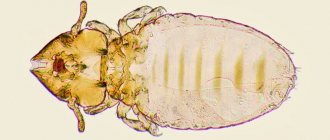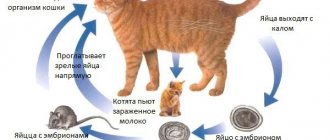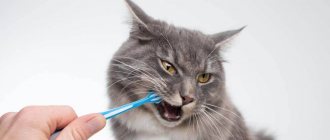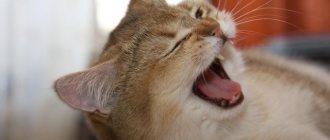Distemper in cats has other official names, so you should not be misled by the question: “What is panleukopenia.” This is a very dangerous virus with a high probability of death, which is difficult to destroy. It can withstand low and high temperatures and, even in unfavorable environmental conditions, remains virulent for up to a year. Under no circumstances should you self-medicate or let the disease take its course. Only if you go to a veterinary clinic does your pet have a chance of survival.
Etiology of feline panleukopenia
- The causative agent of panleukopenia in cats - DNA - containing a virus of the Parvoviridae family
- Representatives of the feline, raccoon, civet, (mustelidae?) families are susceptible to panleukopenia.
- Virus tropism for actively dividing cells
- The virus can replicate in the thymus and lymphoid tissue of dogs
- Mutation of FPV to CPV, ability to infect cats is lost
- CPV-2 was isolated from leopards (an offshoot mutation)
- Confusion with nomenclature
- Representative of the Viverridae family - spotted lingsang
Pathogenesis
Because immune cells in the blood are attacked by various pathogens, this virus can lead to an anemic state and can open the body to infections from other diseases - viral or bacterial.
In the unvaccinated cat population, panleukopenia is one of the most fatal diseases. The causative virus is very stable and can survive for years in a contaminated environment, so the best preventive goal is to vaccinate the entire cat population.
Kittens between two and six months of age are at greatest risk of developing severe symptoms, as are pregnant and immunocompromised cats. In adult cats, panleukopenia is often milder and may even go unnoticed. Fortunately, cats that survive this infection are immune to any further infection by this virus. On the other hand, there are strains of the panleukopenia virus that provide almost 100% mortality.
Consequences and pathological changes in the body
To better understand the danger of panleukopenia, you need to know its consequences and pathological changes in the body. Let's start with lifetime consequences:
- Long-term disorders of hematopoiesis (the process of blood production).
- Neurological disorders are possible.
- Miscarriages, pyometra or severe endometritis, maceration or mummification of fetuses, infertility (and in cats too).
- Growth and developmental disorders are often diagnosed in young animals after panleukopenia. In particular, the pet may remain miniature for the rest of its life.
- If the inflamed mesenteric lymph nodes have been compressing the intestines for a long time, the cat may well suffer from constipation for the rest of its life.
Symptoms and signs of panleukopenia in cats
The gate of infection is the respiratory tract, gastrointestinal tract.
- Affects rapidly dividing cells: lymphoid tissue (bone marrow, thymus) – leukopenia; enterocytes – destruction of enterocytes – disturbance of maldigestion and malabsorption – diarrhea – dehydration, hypoalbuminemia, hypokalemia, hypoglycemia
- Factors complicating the course of panleukopenia: The presence of other gastrointestinal diseases: cystoisosporosis, helminthiasis, giardiasis, cryptosporidiosis, toxoplasmosis, clostridiosis, salmonellosis, eosinophilic, lymphocytic-plasmacytic infiltration of the mucous membrane, etc.; Poor feeding; Chronic viral infections.
- The incubation period for panleukopenia is 2-10 days
- Clinical signs of panleukopenia: at the beginning apathy, hyperthermia, anorexia, pain in the abdominal wall, prolapse of the third eyelid, then (2-5 days) hypothermia, vomiting, diarrhea, stupor, coma, death
Ataxia in kittens with panleukopenia
- Cause: infection of the placenta with a virus, transplacental infection of kittens, cerebellar hypoplasia, keratitis, hydrocephalus, hydroanencephaly, fetal death
Panleukopetia - what is it?
According to experts, this disease is caused by a virus that affects the gastrointestinal tract of the animal. After this, you can observe a decrease or complete disappearance of white blood cells. Most often, kittens and unvaccinated adult cats suffer from panleukopenia. The respiratory tract and heart muscle are also affected. The result of the disease is often severe dehydration of the body, which can lead to the death of the animal. Only timely vaccination can reduce the increase in the incidence of this disease. As well as timely diagnosis and correctly selected treatment.
© shutterstock
Main signs and symptoms of feline panleukopenia
- Vomit
- Diarrhea/bloody diarrhea
- Dehydration
- Weight loss
- Heat
- Anemia (due to low red blood cells)
- Rough and disheveled fur
- Depression
- Complete loss of interest in food
- The cat is hiding
- Neurological symptoms (eg, lack of motor coordination)
- Causes of the disease (Etiology of panleukopenia in cats)
Feline parvovirus (FPV, causative agent of panleukopenia)
is the root cause of panleukopenia in cats. Cats acquire this infection when they come into contact with contaminated saliva, blood, feces, urine or other body fluids. The virus can also be transmitted by people who do not wash their hands properly or change clothes between contacts with cats or by materials such as bedding, food utensils or equipment that have been used on other cats.
Washing your hands with soap and water after handling any animal will minimize the chance of transmitting infection to healthy animals.
This virus can remain on many surfaces, so it is important to use safe and effective methods to prevent transmission of this disease. However, even in the cleanest conditions, small amounts of the virus may remain in the environment in which the infected cat was exposed. Feline parvovirus is resistant to disinfectants and can remain in the environment for up to a year, waiting to cause infection.
Kittens can contract the disease in the womb or through breast milk if the pregnant or nursing mother is exposed. As a rule, an unfavorable prognosis does not apply to those kittens that were exposed to this virus in the womb. They receive immunity for some time after birth (colostral immunity lasts about 14 days after stopping breastfeeding). Such kittens can also be exhibited in nurseries, pet stores, shelters and boarding schools.
Symptoms from the first signs to severe form
At different stages of plague, cats exhibit a large number of characteristic symptoms.
:
- refusal of food, drink and favorite treats;
- a sharp increase in body temperature to 40-41 degrees;
- yellow-green vomit;
- urine of rich yellow and orange color;
- blue discoloration of blood vessels on the roof of the mouth;
- separation of purulent contents from the eyes;
- blood red eye color;
- dry cough due to swelling of the larynx;
- nasal discharge;
- drying of mucous membranes;
- apathetic and depressed state, tendency to solitude;
- diarrhea;
- red purulent spots on the skin;
- trembling and convulsions;
- hard breath.
If one of these symptoms occurs, there is no need to suspect distemper in cats, but the pet's condition will still require examination by a veterinarian. But if several of the mentioned signs coincide, it is better to urgently take your pet to the doctor - it is quite possible that the doctor will confirm the symptoms of distemper in the cat.
Diagnostics
Establishing diagnosis
- Comprehensively: life history data (contact with other cats, place of purchase, visit to a veterinary clinic, hospital treatment), vaccine history (colostral immunity, vaccination window), clinical signs, laboratory tests (general blood count, examination of feces or direct washings). intestines, nasopharyngeal swabs, blood for detection of the virus by PCR - may be false negative), ultrasound
- Blood tests
- White blood cell count less than 5,000
- Lymphopenia
- Thrombocytopenia
- Increased AST, ALT, bilirubin
- Azotemia (usually prerenal causes)
- Hypokalemia
- Hypoalbuminemia
- Hypoglycemia
- Laboratory error - both false negative and false positive information are possible
You will need to provide details about your cat's health and recent actions to your veterinarian. If your cat has recently come into contact with other cats or is going outside at all, it may be important to refer your veterinarian for a proper diagnosis.
Panleukopenia can mimic many other types of diseases
, including poisoning, feline leukemia (FeLV), feline immunodeficiency virus (FIV) and pancreatitis, intestinal and gastric foreign bodies, bacterial infections and helminthic infestations, among others, so it is important to give your veterinarian as much detail as possible so they can prescribe appropriate treatment .
Differential diagnoses for panleukopenia
- Leukemia
- Lymphoma
- Acute poisoning
- Foreign body of the gastrointestinal tract
- Sepsis
Your doctor will then perform a physical examination with routine laboratory tests, including a complete blood count, serum chemistry profile, and urinalysis. Laboratory test results are usually nonspecific, but a significant loss of white blood cells (leukocytopenia) will indicate panleukopenia to your veterinarian.
Feline parvovirus attacks and kills cells that divide rapidly, such as those produced in the bone marrow and intestines, so blood tests usually show a decrease in the number of white cells (leukocytes) and red blood cells.
Myth No. 4. More drugs - better chances
Many owners, frightened by the dangers of the virus, want to get as many prescriptions as possible or add medications themselves after reading advice on the Internet. This is not always advisable.
When prescribing therapy, the doctor focuses on the phase of the disease and the patient’s condition, and if he has not prescribed a drug, then perhaps this drug is not needed at the moment.
Sometimes you can see that people rush to inject an animal with several immunomodulators at once when its immune system is working on its own. Or they give antibiotics until they are needed. For example, if the tests reveal an infection, but the animals suffer from it in a latent form and there are no obvious symptoms of the disease (they eat, play, feel tolerable), antibiotics are not needed.
Treatment of cats with panleukopenia
Sick cats require immediate treatment and often hospitalization. The first main goal of treatment is to restore body fluid levels and electrolyte balance. Specific treatment will depend on the severity of your cat's illness, but it will likely involve hospitalization for several days in an isolation facility to prevent it from spreading to other animals. Since in cats with panleukopenia the immune system practically does not work, sepsis occurs. Therefore, veterinarians prescribe broad-spectrum antibiotics for panleukopenia, usually intravenously.
What is the treatment strategy for panleukopenia in cats?
- Infusion therapy, electrolyte balance monitoring
- Broad-spectrum antibiotics (cefazolin, amoxicillin)
- Parenteral nutrition
- Beta-leukine, roncoleukin, interferon (virbagen), interferon inducers (cycloferon)
- Blood transfusion of a cat that has been vaccinated or has recovered from panleukopenia
- Antiemetics (thiethylperazine, metoclopramide), antispasmodics, thiamine and other B vitamins (prevention of thiamine deficiency)
- Oral bismuth preparations
- Anticholinergic drugs are contraindicated (platifillin) lead to dynamic intestinal obstruction
- Heparin for suspected disseminated intravascular coagulation
- Complications: DIC syndrome with endotoxemia; Ataxia, fetal myocarditis
- Immunity is strong
- Virus shedding after illness can last up to six months
Good supportive care can mean the difference between life and death. Once your cat returns home from the hospital, you will need to isolate her from other cats until all symptoms have resolved and your veterinarian gives the OK. This may take up to 6 weeks.
This infection has a particularly depressing effect on the physical and mental health of the cat. Your cat will need affection and comfort during the recovery period. It goes without saying that you will need to maintain strict hygiene, and given that this infection can remain on surfaces, be especially clean and careful after handling a sick cat so that you do not inadvertently spread the virus to other cats.
If your cat is treated quickly and effectively, he can make a full recovery. It may take several weeks for your cat to fully recover. Unfortunately, the mortality rate from panleukopenia reaches 90%.
Is canine plague dangerous for humans and other animals?
Do not confuse feline and canine distemper - despite the same names, the pathogen is different, so a cat cannot become infected from a dog and vice versa. The virus is not dangerous for people and other animals. But if a sick cat has had contact with other cats, then, in addition to isolation, all contacts need to be given anti-panleukopenia serum or globulin.
If they have not been vaccinated, then 21 days after the administration of the serum, the animals must be vaccinated if symptoms of the disease do not appear. A cat that has recovered from the disease becomes a carrier, and it is not recommended to take other animals for at least a year. The same applies to the situation when the pet died - the new animal will be in danger.
Prevention and control measures for feline panleukopenia
Follow your veterinarian's instructions regarding drug administration, household disinfection, and the need for quarantine. If you have other cats, you will need to monitor them closely for signs of illness. Consult your veterinarian about the possibility of vaccinating other cats at home.
Anything your cat touches should be deeply cleaned and disinfected. Anything that can be washed and dried in a washing machine should be washed, and anything that can be washed in a dishwasher should be washed in a washing machine. This includes bedding, toys, dishes and trays, and a trash can.
Again, keep in mind that even then, you may not be able to remove all traces of the virus. Although your cat will not be susceptible to re-infection after recovery, other visiting cats may still be infected by contaminants that were left behind. You can also infect your friends' cats if you visit them.
Vaccination of cats is the most important means of preventing panleukopenia.
Before you bring a new kitten into your home, find out if it has been vaccinated. Fortunately, the vaccine is so effective that just one dose prevents most cases of panleukopenia virus infections. Be alert for any signs of illness, especially in young kittens, and ask your veterinarian to examine your pet as soon as possible if you notice anything of concern.
Risk factors for the disease
There are several factors that increase the risk of contracting panleukopenia:
- Age up to one year and over 6 years. Most often, newborns, slightly older and elderly individuals get sick. This is due to the fact that the animal’s immunity at a young age is not yet fully formed, and at an older age, on the contrary, it is already weakened.
- Warm season. Outbreaks of the disease occur in spring and summer.
- Living in a house with 2 or more cats. If there are several cats in the house, the risk of contracting panleukopenia increases. It is quite difficult to isolate a sick cat in an apartment from other pets. And even after recovery, the animal remains infectious for 1–2 months.
- High contagiousness (infectiousness) of the disease. Parvovirus is very viable. That is why you need to be very careful when visiting various exhibitions, competitions, veterinary clinics, pet hotels and other places where animals gather with your cat.
- Unscrupulous breeders. They take the kittens away from their mother too early, so the babies do not have time to gain immunity from her milk. In addition, such breeders do not give any vaccinations to their pets for sale. Purchasing a cat from an unverified person is a huge risk.
Good to know
- Trichopolum instructions for veterinary medicine
- Instructions for the use of the antibiotic Baytril in animals
- Instructions for use of metronide
- Instructions for ceftriaxone preparations for animals
- Use of Metrogyl in veterinary medicine
- Instructions for doxycycline in animals
- Metronidazole (Metronidazole) for animals (instructions for use in veterinary medicine, doses, indications and contraindications)
- Atovaquone (ATOVAQUONE)
- Azithromycin, instructions for animal therapy










